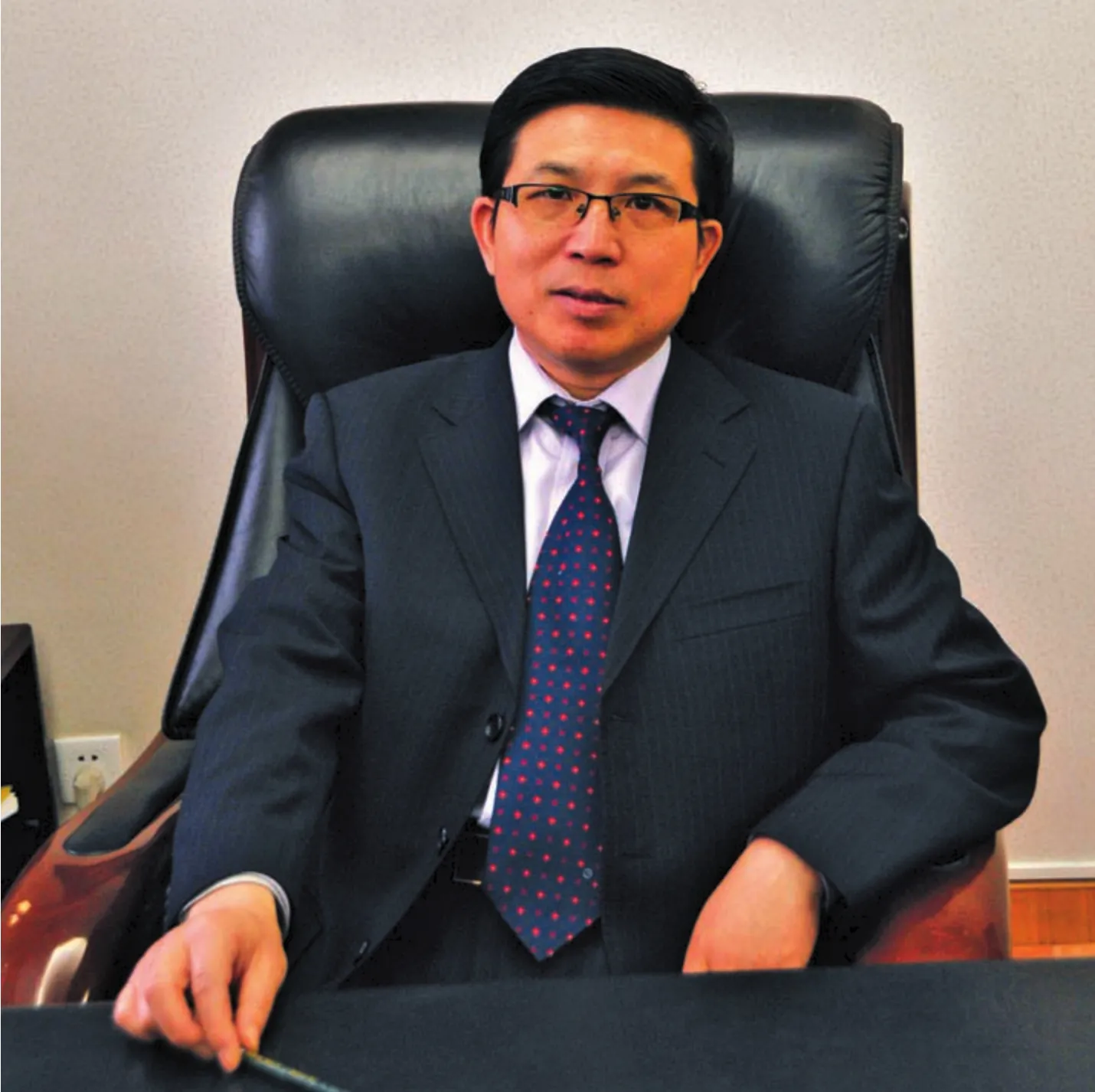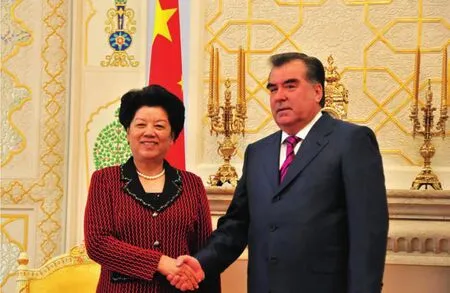Two Decades of Growth
2012-10-14SUNWFNRIN
Two Decades of Growth

SUN WENBIN
This year marks the 20th anniversary of China’s diplomatic relations with Tajikistan, Uzbekistan, Kazakhstan, Kyrgyzstan and Turkmenistan. In an interview withBeijing Review, Fan Xianrong, Chinese Ambassador to Tajikistan, said the Sino-Tajik relationship has been growing rapidly and smoothly in the last 20 years with unprecedented progress in various fields. Excerpts of the interview follow:
Beijing Review: How do you appraise the overall relations between China and Tajikistan in the last two decades?
Fan Xianrong: On January 4, 1992, the two countries signed the joint communiqué on the establishment of diplomatic relations in Dushanbe.Since then, the Sino-Tajik relationship has entered a new era. The last 20 years have seen a swift development of the relationship.
Political mutual trust is growing all the time. Cooperation in economy, trade, transportation, telecommunications, agriculture,infrastructure construction, security and culture has made remarkable progress, which not only deepens the friendship of the two nations, but also brings them substantial benefits.
What is the basis for the stable relationship between the two countries?
As close neighbors, China and Tajikistan have wide common interests and huge potential for cooperation. Over the decades, the two governments have made unremitting efforts to lay a solid foundation for cooperation, and great achievements have been made.
Political mutual trust has been strengthened.Since the establishment of diplomatic ties, offi cial visits have been frequent between the two countries. Personal friendship has also been established between the leaders of the two sides.For example, the deep personal friendship between President Hu Jintao and Tajik President Emomalii Rahmon has provided strong support for the smooth development of the relations.President Hu visited Tajikistan in 2008, while President Rahmon visited China fi ve times from 1993 to 2007. Since 2003, the two leaders have also met for talks many times during international meetings such as Shanghai Cooperation Organization (SCO) summits.
The legal foundation for cementing Sino-Tajik bonds has been improved. In addition to the 1992 joint communiqué, the two countries have signed a series of important documents.In January 2007, during President Rahmon’s visit to China, the two countries signed the Treaty of Good Neighborliness, Friendship and Cooperation, which became the highest achievement in their efforts to develop a legal framework for the Sino-Tajik relationship.
On January 14, 2011, Tajikistan’s parliament rati fi ed the border demarcation protocol between China and Tajikistan. The move showed the two countries’ border issue had been completely settled. So far China and Tajikistan have signed more than 100 documents, providing a sound legal basis for the further progress of their relations.
Moreover, the two countries have engaged in fruitful security cooperation. Mutual exchanges in national defense and public security are frequent.Cooperation in personnel training, intelligence sharing, technological and material assistance, antiterrorism, and the fi ght against organized crime,drug smuggling and human traf fi cking is close.
In which aspects can we say the economy and trade of the two countries are highly complementary? As one of the important overseas investment destinations for Chinese enterprises, which fi elds of Tajikistan are Chinese enterprises interested in?
Economic and trade links between the two coun-tries have grown rapidly over the years.
Their trade volume increased from $2.75 million in 1992 to nearly $1.5 billion in 2010.The trade volume in the first three quarters of 2011 reached $1.47 billion. In the last fi ve years,bilateral trade volume has increased 15 times and the two sides have cooperated in more than 50 large- and medium-sized projects.
Of the $900 million preferential export buyer’s credit that China provided to other SCO members, Tajikistan received more than two thirds. The country spent the money on the Sino-Tajik Friendship Tunnel, the Tajikistan-Uzbekistan highway and two important power transmission lines. The China Road and Bridge Corp. (CRBC) and the Tebian Electric Apparatus Stock Co. Ltd. were contracted to construct these projects.
Apart from the Tajikistan-Uzbekistan highway, Chinese companies have also built the Tajikistan- Kyrgyzstan highway and are building the China-Tajikistan highway. In 2011 when Tajikistan celebrated the 20th anniversary of its independence, the CRBC completed the restoration of Dushanbe’s Rudaki Avenue on schedule.In recent years, Chinese construction companies have undertaken more and more large projects in Tajikistan including the country’s national library, national museum and Foreign Ministry complex.
Tajikistan is rich in mineral resources.There is great potential for cooperation in this fi eld between the two countries. The number of Chinese mineral resource exploitation companies working in Tajikistan and the amount of their investment have been on the rise over the last two decades. The gold exploitation project and leadzinc exploitation project of Zijin Mining Group and Xinjiang Tacheng International Resources Co. Ltd. are very successful, and have become the models for cooperation. Presently, the two Chinese miners have become large taxpayers of the Tajik Government.
Agricultural cooperation between China and Tajikistan has also made headway in recent years. Many enterprises from Xinjiang have come to Tajikistan to contract plots of land for development. They employ advanced farming technologies as well as high-quality seeds to grow rice and cotton and have made good pro fi ts.In the next stage, the two sides will further cooperate on agricultural machinery, seed cultivation and staff training.
China is also an important partner of Tajikistan’s telecom industry. China’s two telecom equipment giants Huawei and ZTE have established good partnerships with local telecom operators, and have become major equipment and service providers of Tajikistan’s telecom industry.
“So far China and Tajikistan have signed more than 100 documents, providing a sound legal basis for the further progress of their relations.”
—Fan Xianrong, China’s Ambassador to Tajikistan
Tajik people share the time-honored Pamir culture with people in China’s Xinjiang Uygur Autonomous Region. In recent years, how have the cultural and economic exchanges between Tajikistan and Xinjiang grown?
The Xinjiang Uygur Autonomous Region is a bridgehead for pragmatic cooperation between the two countries. In recent years, the trade volume between Xinjiang and Tajikistan accounted for 72 percent of the total Sino-Tajik trade volume. Cooperation between Xinjiang and Tajikistan is fruitful and progressing in every fi eld.
In August 2011, Zhang Chunxian,Secretary of the Xinjiang Autonomous Regional Committee of the Communist Party of China,headed a trade delegation to Tajikistan and met with President Rahmon. The two sides exchanged ideas for in-depth cooperation. In addition, trade at the Sino-Tajik Karasu-Kulma border crossing is flourishing. Trade deals here account for 14 percent of the two countries’ total trade volume.
Of the five Chinese art groups that visited Tajikistan in 2011, three were from Xinjiang. In the same year, Tajik art groups also participated in the Xinjiang International Folk Dance Festival in June and the Xinjiang International Children’s Art Festival in August.

CELEBRATING FRIENDSHIP: Tajik President Emomalii Rahmon meets Chinese President Hu Jintao's special envoy Chen Zhili, Vice Chairwoman of the Standing Committee of the National People's Congress of China, in Dushanbe, on January 12, who recently visited Tajikistan and the other four Central Asian nations
